Wireless Joys: Samsung CA750 Monitor Review
Not so long ago, Samsung Electronics presented the CA750 and CA550 monitors on the Russian market, equipped with docking stations and capable of receiving an image via a wireless interface - they even told about the first model once in a blog.

Both models are presented in two versions - with a screen diagonal of 23 inches (C23A750X and C23A550U) and 27 inches (C27A750X and C27A550U), respectively. The device combines low response time (2 ms), FullHD-resolution (1920x1080), high contrast (1 000 000: 1) and large (170 ° / 160 °) viewing angles. Today we will speak in more detail about the Samsung C23A750X , which I managed to get to the test.
The monitor is sold in a small box - it is quite light, despite the diagonal of the device inside. But it is not surprising - the weight of the monitor is a little over 4 kilograms!
')
The package includes the monitor itself, power supply, HDMI-wire and a special USB wireless adapter for external devices. The manual hints that USB 3.0 and D-Sub cables, a USB charging connector and a cloth for wiping the screen were also originally included (or can be optional).
Immediately after the product announcement, a lot of renderings appeared on the net with images of the new product - they could be found everywhere, even on the official website. In reality, the device looks somewhat different (for example, another frame around the display), but in general the percentage of similarity is very, very high. Here are some pictures for visual comparison:

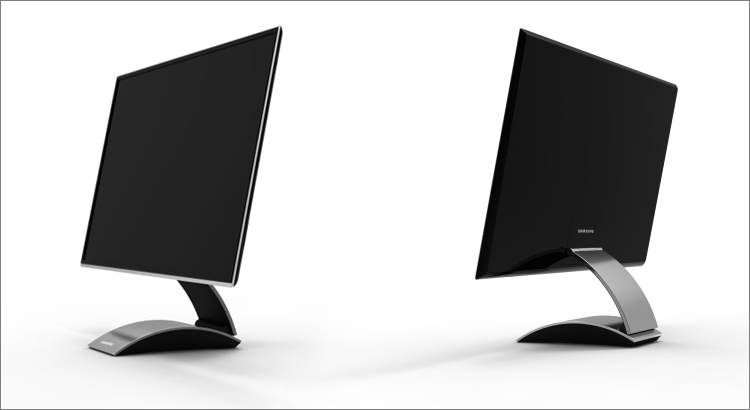
On the front panel there are several touch buttons that are visible or not depending on the situation. The first three buttons are located at the bottom right - power (power), HUB (for hub settings) and an on-screen menu.

The remaining buttons (in the amount of five pieces) are slightly higher - four “arrows” to navigate through the menu and one (central) - to confirm the source selection.
On the left side of the device "legs" are four interfaces: two USB ports (3.0), one HDMI and one audio jack (3.5 mm mini-jack).
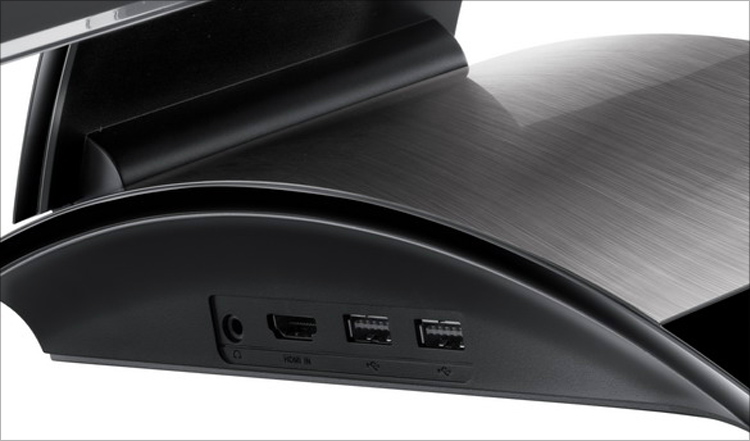
On the right - only 2 USB ports (already version 2.0).
On the back side is a VGA connector, Ethernet and USB ports (“square”), and a power hole from the DC adapter.
-
The movable leg allows you to increase the “clearance” of the monitor (from 3 to 10 centimeters) and the angle of inclination (from 90 degrees to ~ 50). To complete the picture, there is not enough opportunity to turn the screen right and left, but what's not in this model is not that.

I repeat that the monitor is unusually light - on the one hand, additional weight would only add “solidity”, on the other hand - the available weight is not at the expense of stability. The case itself is assembled more than soundly, although it will be quite easy to scratch the plastic of the face - make it a rule to always handle it carefully.

In general, the monitor looks quite nice: a practical matte screen, a thin frame, a multifunctional “leg” - such a device will harmoniously fit into any setting, be it an office desktop or an IKEA bedside table in the living room.
It is necessary to connect the power cable, as the status LED lights up on the top of the docking station - everything works, you just need to choose a video signal source.

There are several connection options (D-Sub / DVI-HDMI / HDMI), but I think it’s more interesting for everyone to learn about the wireless capabilities of this device.
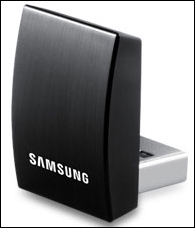 First of all, I took the supplied wireless adapter, inserted it into the free USB connector of the laptop, and began to “click” the buttons while waiting for a miracle. I really wanted to see the image from the laptop on the monitor screen, but alas - the fakir was drunk, the focus failed.
First of all, I took the supplied wireless adapter, inserted it into the free USB connector of the laptop, and began to “click” the buttons while waiting for a miracle. I really wanted to see the image from the laptop on the monitor screen, but alas - the fakir was drunk, the focus failed.
 It turned out that special software is indispensable. “Nuuu started” - I thought, and began to search for the necessary software. On the Internet, of course, he found - the distribution of Samsung Central Station ( current version ) takes about 70 megabytes. Downloading, installing - the Wireless Connection Manager icon appears on the desktop.
It turned out that special software is indispensable. “Nuuu started” - I thought, and began to search for the necessary software. On the Internet, of course, he found - the distribution of Samsung Central Station ( current version ) takes about 70 megabytes. Downloading, installing - the Wireless Connection Manager icon appears on the desktop.
The software is put on all sorts of netbooks, laptops, so that, as you can guess, the function of the HUB Monitor hub, perhaps, the main feature of the monitor, has worked. It lies in the fact that various devices can be connected directly to the monitor, bypassing the computer. Imagine, for example, that you have a “helpless” netbook, the number of connectors (yes the same USB) in which is very limited. We connect its small diagonal to the 23-inch MONITOR, then connect to the monitor, for example, a digital camera and, voila, look at the contents of the camera on the monitor, controlling it from a netbook. That is, this function allows you to control several connected devices from a laptop simultaneously when they are not connected to the laptop itself. If necessary, plug-in USB-devices will be charged - including when the monitor is in power saving mode.
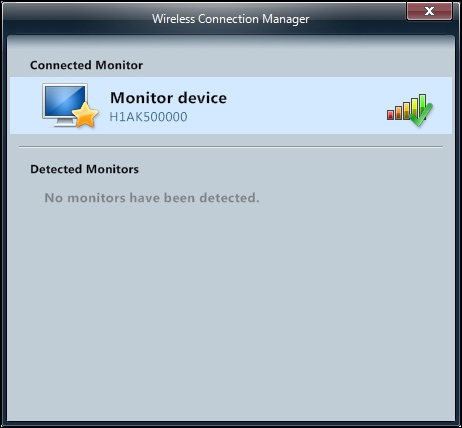
Exactly the same thing can be done with a netbook, without resorting to using a wire - just insert the wireless module into the free USB port and put it on the sofa (within a meter). We connect the speaker system to the monitor and watch a full-fledged movie on a fairly large screen (all in my understanding, TVs for a movie should have a diagonal more than 2 times).
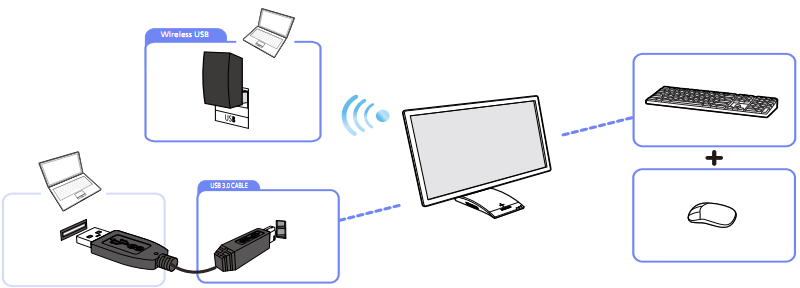
Well, or insert the network cable into the Ethernet connector of the monitor and have the Internet on the connected computer. Well, or ... yes, a lot of things can still be connected here — well, is it convenient ?! Conveniently.
In general, everything worked only after dancing with a tambourine, albeit short-lived - now the necessary signal source (wireless) is selected on the monitor and the happiness becomes complete. If you wish, you can make this connection automatic so that the priority of the connected computer is higher than other signal sources.

The photo (albeit bad) shows that a film is being played on the laptop, which is duplicated on the wireless interface to the monitor on the windowsill - note the absence of any connecting wires between the devices. Unfortunately, among other things, the photo captured the maximum distance at which the film was shown on the “wireless” without artifacts - then began jerks, delays and other irregularities. Ideally, in general, the receiver and transmitter should be on the same level (and looked at each other cordially), but I did not recreate such conditions - maybe some additional centimeters are won there.
Speaking of image quality, many of the company's developments, which were described earlier, gathered in this monitor. For example, Samsung's Magic Angle, Magic Bright and Magic Color technologies - maybe someone no longer believes in the power of all these “magicians,” but sometimes you click on the settings and realize that you lost a lot before =) By the way, Magic Angle is on Actually, it turned out to be a very useful technology - compared to many other monitors, it allows you to output comfortable regardless of where you are (relative to the screen - from the bottom, from the side, from the top, or somewhere else).

All settings are made through the on-screen menu, which, unfortunately, does not hold water, as compared with what I tested recently , this is a step backwards. If my memory serves me, there are 14 languages available in the menu, but Russification is terrible and therefore English is used in the pictures in the article.
Nevertheless, it performs its function (change in brightness / contrast / clarity / resolution / refresh rate, etc.) and here are a few settings screens:


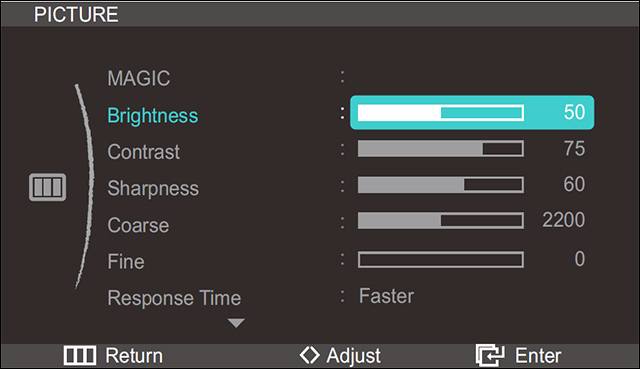
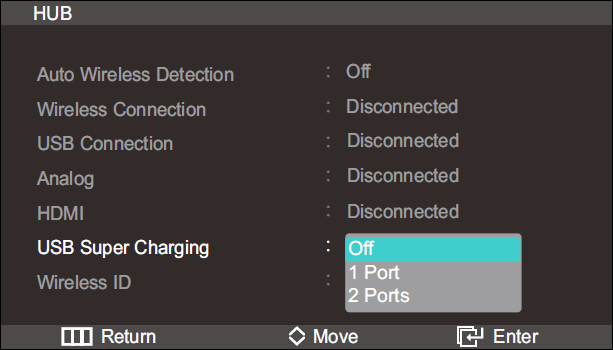
Good design of the device itself. In the spirit of modernity
Large matte display with a fairly high-quality image.
The abundance of modern interfaces, an interesting concept of the hub itself
USB ports support charging devices as well.
Quite adequate price tag.
✘ Brand frame around the screen
✘ Some hemorrhage with pre-setting software
By a completely adequate price tag, I meant 15,000 rubles. If desired, you can pay another 5 thousand and take a model with a diagonal of 27 inches. Here are the technical characteristics of the models:
» Full monitor specifications
» Additional information: Rus | Eng
» Interactive Presentation
» Gallery
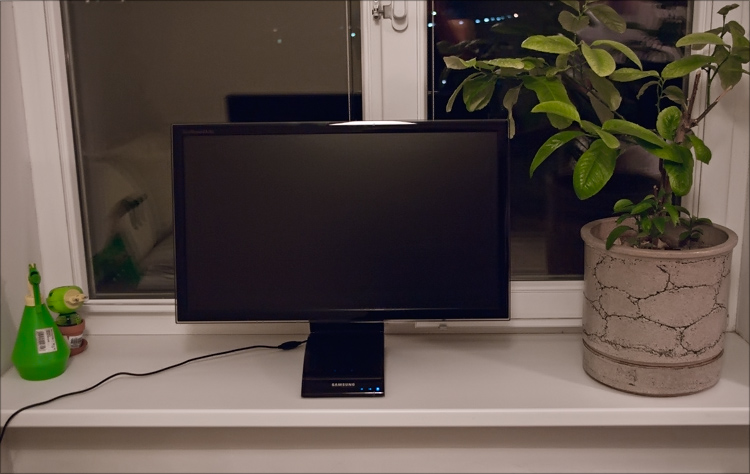
In general, I expected more - that I would only open the box, just turn on the laptop, as soon as I stop and ZAH. Unfortunately, Samsung did not provide such a space - it was necessary to tinker with the software, then with the monitor settings. But on the other hand, everything depends on the non-standard functionality of the Windows operating system, so it was naive to believe that everything will work without unnecessary gestures.
But on the whole, the monitor as such turned out to be very good - the image quality is better than many of those monitors I have seen. And taking into account its communicative capabilities and the presence of promising interfaces, the output is a very stupid device. It would be another resolution higher ...
Ps: The review does not pretend to be complete and professional - only told about their experience and impressions of the device.

Both models are presented in two versions - with a screen diagonal of 23 inches (C23A750X and C23A550U) and 27 inches (C27A750X and C27A550U), respectively. The device combines low response time (2 ms), FullHD-resolution (1920x1080), high contrast (1 000 000: 1) and large (170 ° / 160 °) viewing angles. Today we will speak in more detail about the Samsung C23A750X , which I managed to get to the test.
The monitor is sold in a small box - it is quite light, despite the diagonal of the device inside. But it is not surprising - the weight of the monitor is a little over 4 kilograms!
')
The package includes the monitor itself, power supply, HDMI-wire and a special USB wireless adapter for external devices. The manual hints that USB 3.0 and D-Sub cables, a USB charging connector and a cloth for wiping the screen were also originally included (or can be optional).
▌ Appearance
Immediately after the product announcement, a lot of renderings appeared on the net with images of the new product - they could be found everywhere, even on the official website. In reality, the device looks somewhat different (for example, another frame around the display), but in general the percentage of similarity is very, very high. Here are some pictures for visual comparison:


On the front panel there are several touch buttons that are visible or not depending on the situation. The first three buttons are located at the bottom right - power (power), HUB (for hub settings) and an on-screen menu.

The remaining buttons (in the amount of five pieces) are slightly higher - four “arrows” to navigate through the menu and one (central) - to confirm the source selection.
On the left side of the device "legs" are four interfaces: two USB ports (3.0), one HDMI and one audio jack (3.5 mm mini-jack).

On the right - only 2 USB ports (already version 2.0).
On the back side is a VGA connector, Ethernet and USB ports (“square”), and a power hole from the DC adapter.
-

The movable leg allows you to increase the “clearance” of the monitor (from 3 to 10 centimeters) and the angle of inclination (from 90 degrees to ~ 50). To complete the picture, there is not enough opportunity to turn the screen right and left, but what's not in this model is not that.

I repeat that the monitor is unusually light - on the one hand, additional weight would only add “solidity”, on the other hand - the available weight is not at the expense of stability. The case itself is assembled more than soundly, although it will be quite easy to scratch the plastic of the face - make it a rule to always handle it carefully.

In general, the monitor looks quite nice: a practical matte screen, a thin frame, a multifunctional “leg” - such a device will harmoniously fit into any setting, be it an office desktop or an IKEA bedside table in the living room.
▌ Inner world
It is necessary to connect the power cable, as the status LED lights up on the top of the docking station - everything works, you just need to choose a video signal source.

There are several connection options (D-Sub / DVI-HDMI / HDMI), but I think it’s more interesting for everyone to learn about the wireless capabilities of this device.
 First of all, I took the supplied wireless adapter, inserted it into the free USB connector of the laptop, and began to “click” the buttons while waiting for a miracle. I really wanted to see the image from the laptop on the monitor screen, but alas - the fakir was drunk, the focus failed.
First of all, I took the supplied wireless adapter, inserted it into the free USB connector of the laptop, and began to “click” the buttons while waiting for a miracle. I really wanted to see the image from the laptop on the monitor screen, but alas - the fakir was drunk, the focus failed.The software is put on all sorts of netbooks, laptops, so that, as you can guess, the function of the HUB Monitor hub, perhaps, the main feature of the monitor, has worked. It lies in the fact that various devices can be connected directly to the monitor, bypassing the computer. Imagine, for example, that you have a “helpless” netbook, the number of connectors (yes the same USB) in which is very limited. We connect its small diagonal to the 23-inch MONITOR, then connect to the monitor, for example, a digital camera and, voila, look at the contents of the camera on the monitor, controlling it from a netbook. That is, this function allows you to control several connected devices from a laptop simultaneously when they are not connected to the laptop itself. If necessary, plug-in USB-devices will be charged - including when the monitor is in power saving mode.

Exactly the same thing can be done with a netbook, without resorting to using a wire - just insert the wireless module into the free USB port and put it on the sofa (within a meter). We connect the speaker system to the monitor and watch a full-fledged movie on a fairly large screen (all in my understanding, TVs for a movie should have a diagonal more than 2 times).

Well, or insert the network cable into the Ethernet connector of the monitor and have the Internet on the connected computer. Well, or ... yes, a lot of things can still be connected here — well, is it convenient ?! Conveniently.
In general, everything worked only after dancing with a tambourine, albeit short-lived - now the necessary signal source (wireless) is selected on the monitor and the happiness becomes complete. If you wish, you can make this connection automatic so that the priority of the connected computer is higher than other signal sources.

The photo (albeit bad) shows that a film is being played on the laptop, which is duplicated on the wireless interface to the monitor on the windowsill - note the absence of any connecting wires between the devices. Unfortunately, among other things, the photo captured the maximum distance at which the film was shown on the “wireless” without artifacts - then began jerks, delays and other irregularities. Ideally, in general, the receiver and transmitter should be on the same level (and looked at each other cordially), but I did not recreate such conditions - maybe some additional centimeters are won there.
Speaking of image quality, many of the company's developments, which were described earlier, gathered in this monitor. For example, Samsung's Magic Angle, Magic Bright and Magic Color technologies - maybe someone no longer believes in the power of all these “magicians,” but sometimes you click on the settings and realize that you lost a lot before =) By the way, Magic Angle is on Actually, it turned out to be a very useful technology - compared to many other monitors, it allows you to output comfortable regardless of where you are (relative to the screen - from the bottom, from the side, from the top, or somewhere else).

All settings are made through the on-screen menu, which, unfortunately, does not hold water, as compared with what I tested recently , this is a step backwards. If my memory serves me, there are 14 languages available in the menu, but Russification is terrible and therefore English is used in the pictures in the article.
Nevertheless, it performs its function (change in brightness / contrast / clarity / resolution / refresh rate, etc.) and here are a few settings screens:




▌ Pros and cons
Good design of the device itself. In the spirit of modernity
Large matte display with a fairly high-quality image.
The abundance of modern interfaces, an interesting concept of the hub itself
USB ports support charging devices as well.
Quite adequate price tag.
✘ Brand frame around the screen
✘ Some hemorrhage with pre-setting software
By a completely adequate price tag, I meant 15,000 rubles. If desired, you can pay another 5 thousand and take a model with a diagonal of 27 inches. Here are the technical characteristics of the models:
| Model | 23750 | C27A750 | C23A550 | C27A550 |
|---|---|---|---|---|
| Diagonal | 23 ”(16: 9) | 27 ”(16: 9) | 23 ”(16: 9) | 27 ”(16: 9) |
| Permission | 1920x1080 | 1920x1080 | 1920x1080 | 1920x1080 |
| Response time | 2 ms | 2 ms | 2 ms | 2 ms |
| Brightness | 300 cd / m2 | 300 cd / m2 | 250 cd / m2 | 250 cd / m2 |
| Viewing angles | 170 ° / 160 ° | 170 ° / 160 ° | 170 ° / 160 ° | 170 ° / 160 ° |
| Number of colors | 16.7M | 16.7M | 16.7M | 16.7M |
| Dimensions | 550x434x233 | 638x485x233 | 550x434x233 | 638x485x233 |
» Full monitor specifications
» Additional information: Rus | Eng
» Interactive Presentation
» Gallery

▌ Conclusion
In general, I expected more - that I would only open the box, just turn on the laptop, as soon as I stop and ZAH. Unfortunately, Samsung did not provide such a space - it was necessary to tinker with the software, then with the monitor settings. But on the other hand, everything depends on the non-standard functionality of the Windows operating system, so it was naive to believe that everything will work without unnecessary gestures.
But on the whole, the monitor as such turned out to be very good - the image quality is better than many of those monitors I have seen. And taking into account its communicative capabilities and the presence of promising interfaces, the output is a very stupid device. It would be another resolution higher ...
Ps: The review does not pretend to be complete and professional - only told about their experience and impressions of the device.
Source: https://habr.com/ru/post/133830/
All Articles